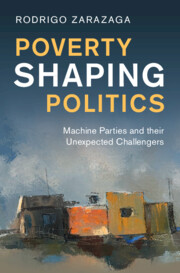Refine search
Actions for selected content:
120 results
Undermining Clientelism with Collective Confidence: Unbundling the Individual and Spillover Effects of Conditional Cash Transfers
-
- Journal:
- Latin American Research Review ,
- Published online by Cambridge University Press:
- 06 October 2025, pp. 1-23
-
- Article
-
- You have access
- Open access
- HTML
- Export citation
Parsing Factional Affiliations among Chinese Political Elites
-
- Journal:
- The China Quarterly / Volume 263 / September 2025
- Published online by Cambridge University Press:
- 08 July 2025, pp. 595-615
- Print publication:
- September 2025
-
- Article
- Export citation
4 - Dilemmas of Success
-
- Book:
- After Equality
- Published online:
- 19 June 2025
- Print publication:
- 03 July 2025, pp 119-148
-
- Chapter
- Export citation
5 - When Capacity Meets Authority
-
- Book:
- Incumbency Bias
- Published online:
- 17 May 2025
- Print publication:
- 05 June 2025, pp 111-140
-
- Chapter
- Export citation
6 - With Narrow Scope Comes Great Advantage
-
- Book:
- Incumbency Bias
- Published online:
- 17 May 2025
- Print publication:
- 05 June 2025, pp 141-163
-
- Chapter
- Export citation
10 - Final Remarks
- from Part V - Conclusions in Comparative Perspective
-
- Book:
- Poverty Shaping Politics
- Published online:
- 05 May 2025
- Print publication:
- 22 May 2025, pp 239-248
-
- Chapter
- Export citation

Poverty Shaping Politics
- Machine Parties and Their Unexpected Challengers
-
- Published online:
- 05 May 2025
- Print publication:
- 22 May 2025
Ignoring Women’s Performance: A Survey Experiment on Policy Implementation in Argentina
-
- Journal:
- British Journal of Political Science / Volume 55 / 2025
- Published online by Cambridge University Press:
- 02 April 2025, e54
-
- Article
-
- You have access
- Open access
- HTML
- Export citation
24 - Papal Patronage and the Arts: From the Early Christian Period to the Twentieth Century
- from Part IV - Education, Culture, Arts
-
-
- Book:
- The Cambridge History of the Papacy
- Published online:
- 28 February 2025
- Print publication:
- 20 March 2025, pp 681-702
-
- Chapter
- Export citation
A Korean Tragedy
-
- Journal:
- Asia-Pacific Journal / Volume 15 / Issue 16 / August 2017
- Published online by Cambridge University Press:
- 14 March 2025, e3
-
- Article
-
- You have access
- Open access
- Export citation
7 - Which Electoral Districts Get More Money
-
- Book:
- Dominance Through Division
- Published online:
- 01 March 2025
- Print publication:
- 06 March 2025, pp 233-271
-
- Chapter
- Export citation
9 - Conclusion
-
- Book:
- Dominance Through Division
- Published online:
- 01 March 2025
- Print publication:
- 06 March 2025, pp 311-320
-
- Chapter
- Export citation
1 - Introduction
-
- Book:
- Dominance Through Division
- Published online:
- 01 March 2025
- Print publication:
- 06 March 2025, pp 1-23
-
- Chapter
- Export citation
3 - A Theory of Group-Based Clientelism
-
- Book:
- Dominance Through Division
- Published online:
- 01 March 2025
- Print publication:
- 06 March 2025, pp 73-107
-
- Chapter
- Export citation
2 - Imperial Networks of Patronage
-
- Book:
- Global Servants of the Spanish King
- Published online:
- 20 February 2025
- Print publication:
- 27 February 2025, pp 77-127
-
- Chapter
- Export citation
The Machine Works: Why Turnout Buying is More Effective Than it Appears
-
- Journal:
- British Journal of Political Science / Volume 55 / 2025
- Published online by Cambridge University Press:
- 12 February 2025, e13
-
- Article
-
- You have access
- Open access
- HTML
- Export citation
Why Is Participation Low in Referendums? Lessons from Latin America
-
- Journal:
- Latin American Research Review / Volume 60 / Issue 2 / June 2025
- Published online by Cambridge University Press:
- 28 January 2025, pp. 275-297
-
- Article
-
- You have access
- Open access
- HTML
- Export citation
Cross-border clientelism, commitment, and the protraction of irredentist conflicts
-
- Journal:
- European Journal of International Security / Volume 10 / Issue 3 / August 2025
- Published online by Cambridge University Press:
- 27 November 2024, pp. 350-373
-
- Article
-
- You have access
- Open access
- HTML
- Export citation
Driven by Clients: A Variant of Clientelism and Its Consequences for Democracy
-
- Journal:
- Latin American Research Review / Volume 60 / Issue 2 / June 2025
- Published online by Cambridge University Press:
- 20 November 2024, pp. 298-316
-
- Article
-
- You have access
- Open access
- HTML
- Export citation
Participatory clientelism: A socio-spatial approach to popular politics in Buenos Aires
-
- Journal:
- Latin American Politics and Society / Volume 67 / Issue 1 / February 2025
- Published online by Cambridge University Press:
- 19 September 2024, pp. 1-18
-
- Article
-
- You have access
- Open access
- HTML
- Export citation
